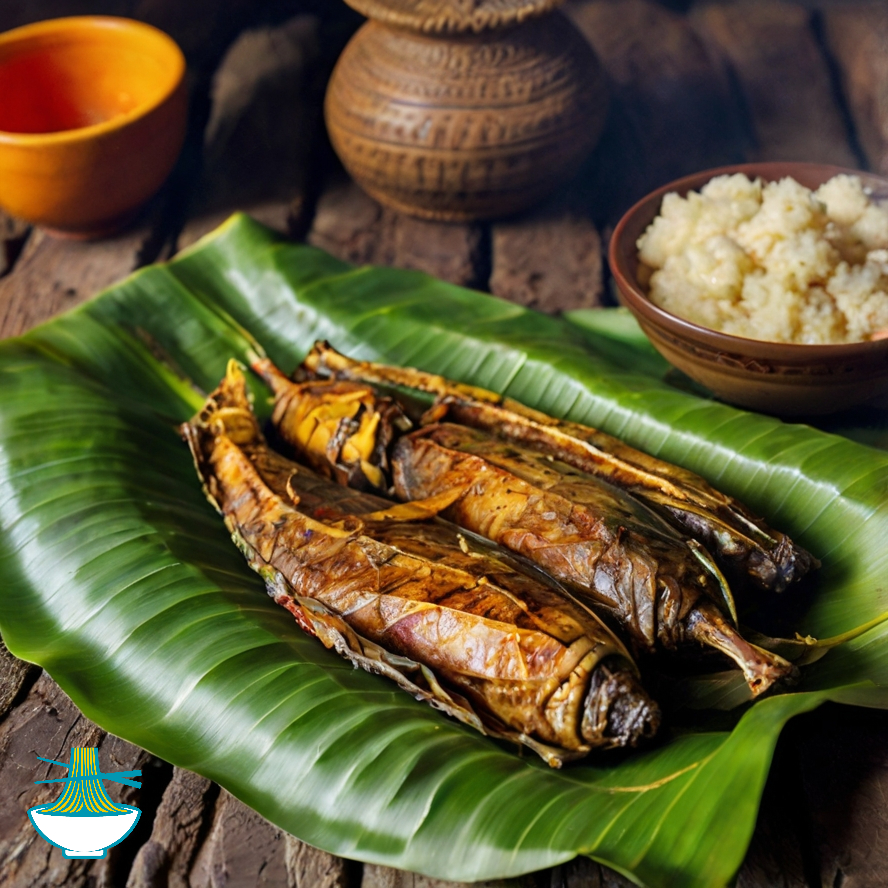Liboke is a traditional Congolese cooking method where fish or meat is wrapped in banana leaves and steamed over hot coals. This technique, deeply rooted in the Congo Basin, has been passed down through generations and is celebrated for its ability to infuse food with a unique, earthy flavor. The use of banana leaves not only imparts a distinct taste but also helps to retain moisture and nutrients, making the dish both flavorful and nutritious.

Historically, the Liboke method was developed as a way to cook food using minimal resources. The abundance of banana plants in the region provided an ideal, eco-friendly cooking vessel that required no additional cookware. This method is still popular today, both for its cultural significance and its health benefits, offering a low-fat, nutrient-rich alternative to frying or baking in oil.
Ingredients:
- Fresh whole fish or meat (e.g., chicken)
- Salt
- Pepper
- Garlic
- Onions
- Tomatoes
- Vegetables of your choice
- Banana leaves
Instructions:
1. Prepare the Meat or Fish: Clean and season your fish or meat with salt, pepper, garlic, and other desired spices.
2. Prepare Banana Leaves: Rinse and dry the banana leaves. Soften them over a flame.
3. Wrap the Liboke: Place the seasoned fish or meat on the banana leaves, add sliced onions, tomatoes, and vegetables, and wrap tightly.
4. Steam Over Coals: Place the wrapped Liboke on hot coals, cover, and steam for 30-40 minutes.
5. Serve: Unwrap and serve with vegetables and your favorite sides.
Congo Liboke is more than just a cooking method; it's a journey into the heart of African culinary tradition. Whether you choose fish or meat, this dish offers a flavorful, healthy, and eco-friendly way to enjoy a meal with deep cultural roots.

Nutrition Value:
1. Fresh whole fish or meat (e.g., chicken)
- Calories: Fish typically has 80-150 calories per 3-ounce serving; chicken has around 140-220 calories per 3-ounce serving.
- Carbohydrates: Negligible in both fish and meat.
- Protein: Fish provides about 15-25 grams of protein per 3-ounce serving; chicken offers around 21-25 grams.
- Fat: Fish has 2-10 grams of fat, depending on the type; chicken has about 3-10 grams, with variations in fat content based on the cut.
- Sodium: Fish and chicken naturally contain low levels of sodium but can vary based on preparation.
- Cholesterol: Fish contains about 60-80 mg of cholesterol per 3-ounce serving; chicken has 70-80 mg.
- Vitamins: Fish is a good source of B vitamins, especially B12 and niacin. Chicken also provides B vitamins, including B6 and B12.
- Minerals: Fish offers minerals such as iodine, selenium, and magnesium. Chicken provides iron and zinc.
- Nutritional Benefit: Rich in high-quality protein, omega-3 fatty acids (in fatty fish), and essential vitamins and minerals that support overall health, including heart health and muscle function.
2. Salt
- Calories: 0 calories.
- Carbohydrates: 0 grams.
- Protein: 0 grams.
- Fat: 0 grams.
- Sodium: 2,300 mg per teaspoon.
- Cholesterol: 0 mg.
- Vitamins: None.
- Minerals: Contains sodium, essential for fluid balance and nerve function.
- Nutritional Benefit: Enhances flavor, but excessive intake can lead to health issues like hypertension. Moderation is key.
3. Pepper
- Calories: 6 calories per teaspoon.
- Carbohydrates: 1.5 grams per teaspoon.
- Protein: 0.2 grams per teaspoon.
- Fat: 0.1 grams per teaspoon.
- Sodium: 0 mg.
- Cholesterol: 0 mg.
- Vitamins: Provides small amounts of vitamin K and some vitamin C.
- Minerals: Contains potassium, calcium, and iron.
- Nutritional Benefit: Adds flavor without sodium and provides antioxidant properties that may aid digestion and metabolism.
4. Garlic
- Calories: 4 calories per clove.
- Carbohydrates: 1 gram per clove.
- Protein: 0.2 grams per clove.
- Fat: 0 grams.
- Sodium: 1 mg per clove.
- Cholesterol: 0 mg.
- Vitamins: Rich in vitamin C and B vitamins.
- Minerals: Contains calcium, iron, magnesium, and potassium.
- Nutritional Benefit: Known for its anti-inflammatory and immune-boosting properties. Supports heart health and may reduce the risk of certain cancers.
5. Onions
- Calories: 45 calories per 100 grams.
- Carbohydrates: 11 grams per 100 grams.
- Protein: 1 gram per 100 grams.
- Fat: 0.1 grams per 100 grams.
- Sodium: 4 mg per 100 grams.
- Cholesterol: 0 mg.
- Vitamins: Provides vitamin C and some B vitamins.
- Minerals: Contains potassium, calcium, and magnesium.
- Nutritional Benefit: Offers antioxidant properties and may help reduce inflammation and support heart health.
6. Tomatoes
- Calories: 18 calories per 100 grams.
- Carbohydrates: 3.9 grams per 100 grams.
- Protein: 0.9 grams per 100 grams.
- Fat: 0.2 grams per 100 grams.
- Sodium: 5 mg per 100 grams.
- Cholesterol: 0 mg.
- Vitamins: High in vitamin C and provides vitamin A and some B vitamins.
- Minerals: Contains potassium and iron.
- Nutritional Benefit: Rich in antioxidants like lycopene, which may reduce the risk of certain diseases and support overall health.
7. Vegetables of your choice
- Calories: Varies by vegetable; generally 20-50 calories per 100 grams.
- Carbohydrates: Typically 5-10 grams per 100 grams.
- Protein: Low, about 1-2 grams per 100 grams.
- Fat: Very low, about 0.1-1 gram per 100 grams.
- Sodium: Low, about 10-50 mg per 100 grams.
- Cholesterol: 0 mg.
- Vitamins: Varies; generally high in vitamins A, C, and K.
- Minerals: Contains potassium, magnesium, and calcium.
- Nutritional Benefit: Provides essential vitamins, minerals, and fiber. Supports overall health, aids digestion, and may help prevent chronic diseases.
8. Banana leaves
- Calories: Minimal; not typically consumed.
- Carbohydrates: Negligible.
- Protein: Negligible.
- Fat: Negligible.
- Sodium: Negligible.
- Cholesterol: 0 mg.
- Vitamins: Contains trace amounts of vitamins.
- Minerals: Contains some minerals but not significant in diet.
- Nutritional Benefit: Primarily used for wrapping and cooking. Adds flavor and helps retain moisture in dishes.


Comments